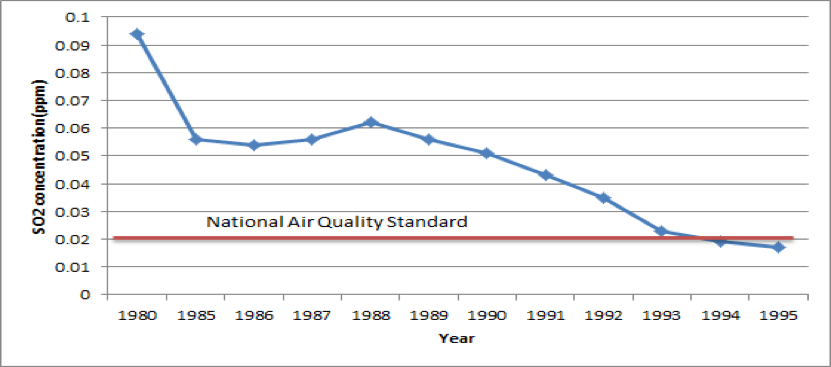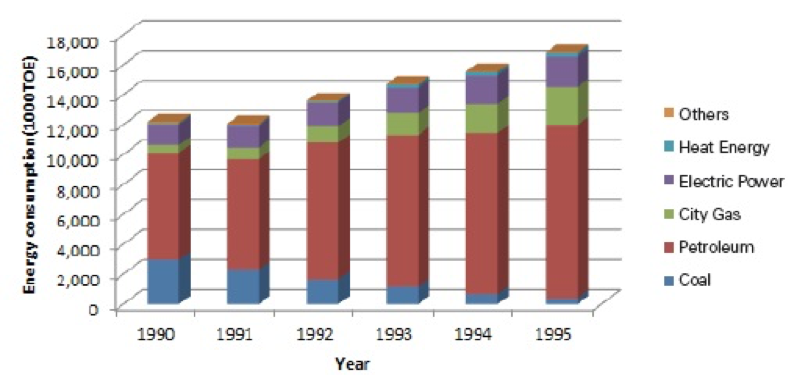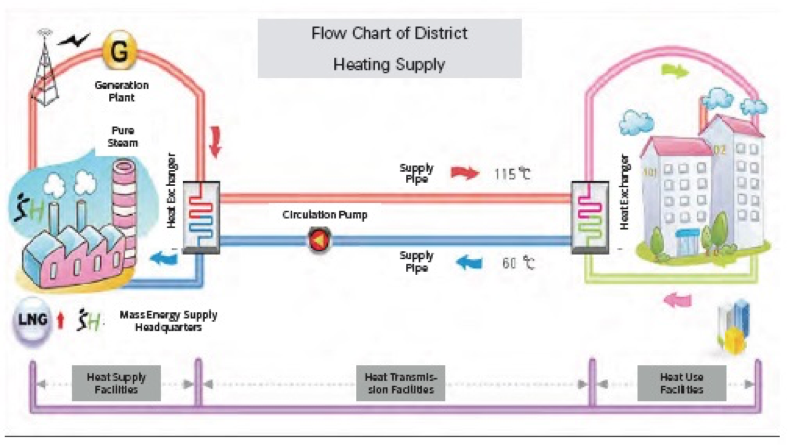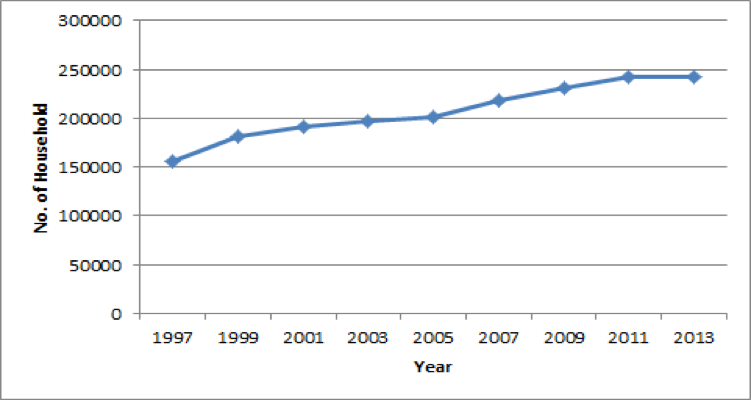Clean Fuel Supply Project
Background
The main energy source in the 1960s was cheap coal, which made up around 40% of total energy consumption at that time. In the 1970s, oil replaced coal and became the main energy source, increasing dramatically as the heavy chemical industry developed, and the standard of living greatly improved.
The major sources of SO₂ emissions are fossil fuels such as coal and oil. The sulfur content of fossil fuels is relatively higher than city gas and LPG. In the 1990s, the SO₂ concentration was still very high, as around 70% of the households in Seoul used coal briquettes for heating. Accordingly, the Seoul Metropolitan and central governments planned to expand the supply of clean fuels and introduce a variety of projects to reduce SO₂ emissions.
<Figure 1> Changes in Annual Average SO₂ Pollution in Seoul


<Figure 3> Change in Number of Households by Heating Fuel in Seoul

Expansion of the Supply of Low Sulfur Oil
To fundamentally reduce SO₂ emissions from fuel, Seoul introduced standards for sulfur content of diesel and heavy oil and applied them in Seoul (the first time in Korea) in 1981. These standards have been strengthened several times and the relevant areas continuously expanded. As a result of the strict standards, only heavy fuel oil with less than 0.3% sulfur content, and diesel with less than 0.1% are currently supplied.<Table 1> Change in Sulfur Content of Heavy Oil & Diesel
| Heavy Oil | Diesel | |
| 1981 | 1.6% | 0.4% |
| 1993 | 1.0% | 0.2% |
| 1997 | 0.5% | 0.1% |
| 2001 | 0.3% | 0.1% |
Regulations to Prohibit the Use of Solid Fuels
Mandatory Use of Clean Fuel
| Boiler Capacity | Area of Apartment | Power Plant | |
| 1988 | At least2 tons | - | |
| 1990 | At least 1 ton | At least 35 pyeong | |
| 1991 | At least 0.5 ton | At least 30 pyeong | All power plants |
| 1992 | - | At least 25 pyeong | Cogeneration plants for business use |
| 1994 | At least 0.2 ton | - | |
| 1995 | - | At least 21 pyeong | |
| 1996 | - | At least 18 pyeong | |
| 1997 | - | At least 12.1 pyeong |
Expansion of City Gas (LNG) Supply to General Housing
- Overview
Seoul implemented a variety of policies to expand the supply of city gas by introducing a system that imposes a part of the cost on consumers through their city gas bills to secure the funds needed for city gas suppliers, financing for replacement of old pipelines to increase stability of supply and adopting a financing system for city gas users.

- Raising a Fund for & Operation of the City Gas Project
◦ Ordinance: Enactment of an ordinance on a fund for installation of the city gas project in Seoul in 1992
◦ Purpose for Raising the Fund: To provide low interest loans to city gas suppliers to cover a certain amount of the installation cost for natural gas infrastructure necessary for the quick expansion of supply
◦ Use of the Fund
- Loans for installation of pipes to provide city gas to public bath facilities planning fuel conversion
- Loans for installation of compressed natural gas stations for city buses and the related pipes
◦ Beneficiaries of the Fund: City gas providers whose business meeting funding criteria
◦ Fundraising Method: Contribution from Seoul’s general account and earnings generated through operation of the Fund
◦ Fund Operation & Management
- Fund Management: Consignment management (Woori Bank, Kookmin Bank)
- Loan Limit: Up to 80% of the costs for installing city gas supply facilities
- Repayment Conditions: Level repayment in 5 years with a 3-year grace period
- Loan Interest: Annual interest of 4.5% (annual lending interest rate of 3.8%)
◦ Loan Process
- Mayor: Review of construction results → Decision on loan amount → Notification of loan handling bank to the city gas supplier
- Loan Handling Bank: Review of construction details, etc. → Funds lent (← Seoul City) → Loan (→City Gas Supplier)
<Figure 5> Amount of Fund & Loan Process


| Submission of Loan Approval Application (Installation Site, Scale, Investment, Amount, etc.) | Loan Approval & Notification of Assignment | Application for Loan (Within the Loan Limit) | Evaluation of Loan & Notification of Approval | Loan Requisition |
| City Gas Supplier>Mayor | Mayor> City Gas Supplier | City Gas Supplier>Bank | Bank> City Gas Supplier | City Gas Supplier>Bank |
| Application of Loan Lending | Funds lent | Loan | ||
| Bank > City | Mayor>Bank | Bank> City Gas Supplier |
Expansion of Supply of Mass Energy (District Heating)
- Overview
The Mass Energy project aims to supply the energy (heat or heat & electricity) produced by one or more concentrated energy plants (cogeneration plants, heating-only boilers, resource recovery facilities, etc.) collectively to numerous users in residential areas, commercial areas and industrial complexes.
<Figure 6> Flow Chart of District Heating Supply

History
In 1984, Seoul provided around 26,000 households with heat in this way. This number exceeded 240,000 in 2013.

The Gangseo Region Project - Process
◦ May 1983: Confirmation of New Town Development Plan in Mok-dong (Adoption of district heating method)
◦ Oct. 1983: Submission of Mass Energy Supply Project Plan (Draft) for Mok-dong Area
◦ Dec. 1983: Public announcement of the Ordinance on Implementation and Consignment of Mass Energy Supply Project
◦ Dec. 1983: Consignment agreement for the Mass Energy Supply Project for Mok-dong (Consignee: Korea Energy Management Corporation)
◦ Mar. 1984: Commencement of design service contract
◦ Aug. 1984: Permission acquired for heat supply project
- Supply Target: 26,629 households in the new towns of Mok-dong and Sinjeong-dong
- Facility Scale: Heat transmission pipes (20 km), cogeneration boiler (1 unit of 100 tons/h and turbine/generator 21 MW), heating-only boilers (2 units of 140 tons/h, 2 units of 80 tons/h and 3 units of 10 tons/h)
- Project Period: Dec. 1983 - Dec. 1987
- Project Budget: KRW 36.199 billion
◦ Nov. 1984: Construction begins on waste incinerator (Completed on Dec. 31st, 1986)
◦ Jan. 1985: Construction begins on cogeneration plant (Completed on Dec. 31st, 1987)
◦ Oct. 1985: Construction begins on heat transmission facilities (Completed Nov. 30th, 1987)
◦ Nov. 1985: Start of the 1st phase heat supply (Mok-dong Apt. 1 District, 1,882 households)
◦ Aug. 1990: Confirmation of Mass Energy Supply Project for Gayang and Banghwa Apt. 1 District
- Supply Target: 24,314 households in Gayang and Banghwa Apt. 1 District
- Facility Scale (Linked to the existing Mok-dong Cogeneration Plant): heating-only boilers (2 units of 110 tons/h), heat transmission pipes (31.6 km), 1 booster pump site
- Project Period: Aug. 1990 - Nov. 30th, 1993
- Project Budget: KRW 30.603 billion
◦ Apr. 1993: Confirmation of Mass Energy Supply Project for Deungchon and Banghwa Apt. 2 District
- Supply Target: 14,365 households in Deungchong and Banghwa Apt. 2 District
- Facility Scale (Linked to the existing Mok-dong Cogeneration Plant): heating-only boiler (1 unit of 110 tons/h, heat transmission pipes (11.4 km)
- Project Period: Apr. 1993 - Jan. 10th, 1995
- Project Budget: KRW 8.961 billion
The Nowon Region Project - Process
◦ Oct. 1991: Service agreement for the Basic Plan for Mass Energy Supply Project in Nowon Region
- Use of incinerator heat from the Sanggye Resource Recovery Facility
◦ Jun. 1992: Confirmation of Mass Energy Supply Project for Nowon Region
- Supply Target: 104,968 households in Nowon-gu, Dobong-gu and Jungnang-gu
- Facility Scale: Cogeneration boiler (1 unit of 150 tons/h and turbine generator 37,000 kW), heating-only boilers (4 units of 150 tons/h), heat transmission pipes (80 km)
- Project Budget: KRW 80.760 billion
- Project Period: Jun. 1992 - Dec. 1996
◦ Jul. 1993: Permission for Mass Energy Project
◦ Dec. 1993: Construction begins on Nowon Cogeneration Plant
◦ Dec. 1993: Construction begins on installation of heat transmission pipes
◦ Dec. 1994: Heat supply begins (3,420 households in Gongneung 1 Land Development District)
◦ Dec. 1996: Completion of Nowon Cogeneration Plant
◦ Oct. 2009: Completion of the Fuel Cell (2.8 MW) Generation Plant in the Nowon Cogeneration Plant
<Figure 8> Status of Consignment for the Mass Energy Supply Project
- Dec. 20th, 1983 ~ Dec. 31st, 1998 (Consignor: Seoul Mayor / Consignee: Korea Energy Management Corporation)
- Jan. 1st, 1999 ~ Dec. 31st, 2001 (Consignor: Seoul Mayor / Consignee: Seoul Energy)
- Jan. 1st, 2002 ~ Present (Consignor: Seoul Mayor / Consignee: SH Corporation)
| Classification | Gangseo Region (Mok-dong Cogeneration Plant) |
Nowon Region (Nowon Cogeneration Plant) |
| Location (Site Area) |
Mok-dong Seo-ro 20 (Mok-dong 900), Yangcheon-gu, Seoul (53,302.4㎡) | 99 Deongneung-ro 70 gil (Sanggye-dong), Nowon-gu, Seoul (24,356.7㎡) |
| Service Area | 9 dong in 3 gu-districts (Gangseo-gu, Yangcheon-gu, Guro-gu) | 11 dong in 4 gu-districts (Nowon-gu, Dobong-gu, Jungnang-gu, Uijeongbu) |
| No. of Target Households | 114,659 households (211 buildings) | 127,545 households (47 buildings) |
| Facility Capacity |
|
|
| Start of Heat | Nov. 20th, 1985 | Dec. 8th, 1994 |
<Mok-dong Cogeneration Plant> |
<Nowon Cogeneration Plant> |
Project Effect
◦ Reduction of sulfur oxide (SOx), nitrogen oxide (Nox) and fine dust emissions thanks to the improvement of the air from reduced fuel use and intensive environmental management
◦ Contribution to resolving power plant site problems and reducing the loss of transmitted power
<Figure 9> Comparison of Efficiency between the Existing Generation Method & Cogeneration Method

Conclusion and Implication
Project Outcomes

.png)
Future Tasks
To address these issues, Seoul has planned and implemented ways to expand the use of new and renewable energy, including geothermal heat, sunlight, solar heat and fuel cells. Specifically, Seoul has focused on expansion of facilities related to solar power, fuel cells and geothermal heat and on heat generation from waste. As a result, the total production of new and renewable energy in Seoul has increased nearly three times from 78,000 TOE in 2003 to 233,000 TOE in 2012. Nonetheless, the amount of new and renewable energy produced in Seoul is just 2.6% of nationwide production and makes up only 1.5% of total energy consumption in Seoul. As the capital facilitates introduction of solar power facilities as a part of its policy of “One Less Nuclear Plant,” the importance of solar generation is expected to increase significantly.
References
The Seoul Metropolitan Government, White Paper on Energy, 2011 and 2012
The Seoul Metropolitan Government, White Paper on Energy, 2007 and 2008
The Seoul Metropolitan Government, White Paper on Energy, 2002 and 2003
The Seoul Metropolitan Government, Analysis of Air Pollution, 1995 and 1996
The Seoul Metropolitan Government, Environment of Seoul in 2000, White Paper on Environment, 2000
The Seoul Metropolitan Government, Evaluation Report on Seoul Air Quality, 2012 and 2013
Ministry of Environment, 2004, 2005 Annual Report on Air Environment